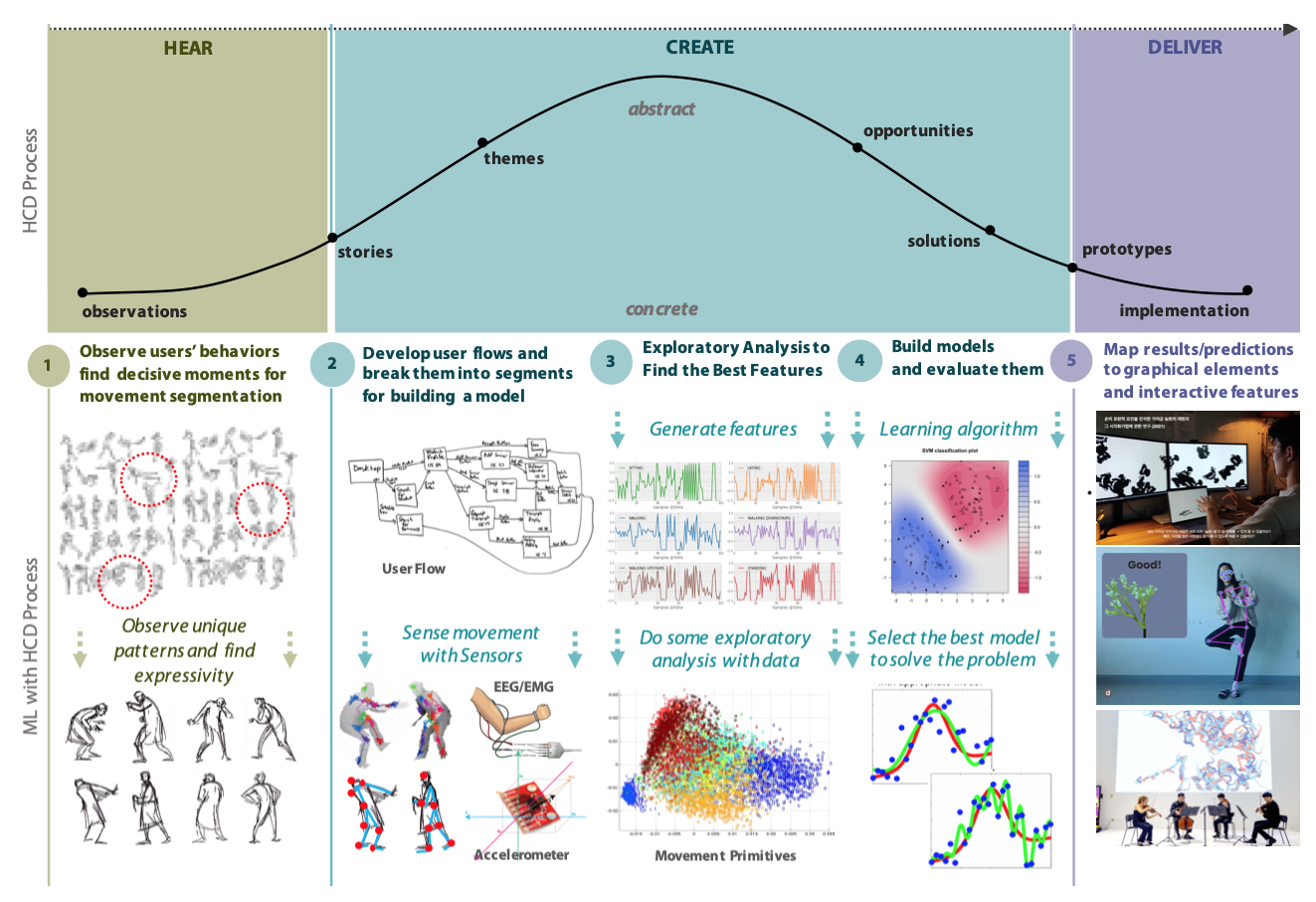Vision

Expressive Computing Lab explores the design and creation of interactive systems that harness the power of artificial intelligence (AI) to enable more expressive, creative, and emotionally engaging interactions and experiences between humans and machines. Our vision is to be a pioneer for the ‘creative use of AI,’ where AI and design are seamlessly integrated to enable new forms of human expression, facilitate human-AI co-creation, and explore the design implications of AI-mediated communication and creative works.
Researching AI from a design perspective is crucial because it brings unique considerations and approaches that differ from model-based AI research and HCI, which focuses on enabling technology research. Instead of focusing on technical advancement and optimization, our design-oriented AI research prioritizes human-centered values, aesthetic sensibilities, and cultural contexts. We uniquely investigate how AI can amplify human creativity, facilitate artistic expression, empower inclusive decision-making, and address cultural preservation—blending technological advancement with humanistic inquiry in ways neither field could achieve alone. Our lab ensures that a deep understanding of human needs, desires, and experiences guides the development and application of AI, informed by design principles. This approach demonstrates how future design research can bridge the gap between AI’s technical capabilities and the real-world contexts in which it is deployed, leading to the creation of AI systems that are not only functional but also meaningful, engaging, and socially responsible. Embracing AI in the field of design requires a fundamental shift in the design process. Designers must adopt an interdisciplinary and agile approach, collaborating closely with engineers, scientists, and users to define desired AI capabilities, gather relevant data, and iteratively test and refine AI pipelines and interactions. This approach places a strong emphasis on defining a design problem, considering the application of AI, ethical considerations in the human-AI feedback loop, and aligning AI with human values and needs.
Our lab explores ways to utilize AI as a new design tool, material, and media, and is expanding the boundaries of what is possible at the intersection of AI and design through an approach based on human-centered values and socially responsible practices. Our lab explores AI in three main directions: AI as an emerging Tool, Material, and Medium for design.
AI as a Design Tool
Our research, conducted from 2019 to 2025, demonstrates how AI can fundamentally transform the design process. In particular, research on using AI for early-stage concept ideation and revision in fashion design (ADR’24) and empirical research on human-AI co-creation in fashion design ideation and sketching (CVPR Workshop’24) explore how AI enhances the creative process from a designer’s perspective. These studies show that AI can fundamentally enhance and transform the design process by proposing new inspiration and collaboration processes for human-AI co-creation.
AI as a Design Material
We integrate AI as an essential component of interactive systems to implement interfaces that are more intelligent, adaptive, and engaging than ever before. The research on “Designing Interfaces for Text-to-Image Prompt Engineering Using Stable Diffusion Models” (IASDR’23) demonstrates how designers adopt generative AI to develop more intelligent and expressive design tools.
“Expanding the Design Space of Vision-based Interactive Systems for Group Dance Practice” (DIS’24) and “CheerUp: A Real-time Ambient Visualization of Cheerleading Pose Similarity” (IUI’23 Poster) explore how to use AI to expand the design space of interactive dance practice systems from single-user practice environments to multi-user, group-based scenarios. Additionally, “Representing the Timbre of Traditional Musical Instruments Based on Contemporary Instrumental Samples Using DDSP” (UIST’23 Poster) and “Designing an Intelligent Learning System for Practicing the Oboe Embouchure” (UBICOMP’22 Workshop) demonstrate the diverse possibilities of AI as a design tool and as a new material for solving culture-related problems.
AI as a Design Media
Our lab enables new forms of artistic expression through AI, facilitates collaboration between artists and AI, and explores the cultural implications of AI. “Toward a Non-Fungible Experience: The Emerging Media Art Performance of Eine Kleine Nachtmusik” (SIGGRAPH Asia’22), “Particling Night: The Design of an Emerging Media Artwork as a Tool for Reflection on Superficiality of Social Media” (IASDR’23), and ISEA’19 papers, Misplaced Euphoria: Developing Kinesthetic Empathy Through Interactive Performance” and “omputational Impressionism: Aesthetic Transference Between Impressionism and Emerging Media Arts”, demonstrate how future artists and designers can use AI to create interactive and thought-provoking experiences, push the boundaries of artistic expression, and engage diverse audiences through questions for society.
“Symphonic Dissonance: Aesthetics of Connectivity as a Theoretical Framework for Designing Interactive Media Art for Climate Crisis Awareness” (ISEA’25) and “Understanding the Aesthetics in AI-Generated Images through the Concept of Decisive Moment” (ISEA’25) explore how AI can be used to raise awareness of important social issues such as climate change, while “Recomposed Seasons: An Immersive Encounter with Climate Change” (ISEA’25) implements these concepts in an actual artwork.
AI for Critical Thinking and Decision-Making
As a recent research direction, our lab explores ways to use artificial intelligence to promote critical thinking and amplify minority opinions in group decision-making processes. “Conversational Agents as Catalysts for Critical Thinking: Challenging Social Influence in Group Decision-making” (CHI’25 LBW) and “Amplifying Minority Voices: AI-Mediated Devil’s Advocate System for Inclusive Group Decision-Making” (IUI’25 Poster) present how AI can encourage diverse perspectives in group discussions and promote more inclusive decision-making.
Our vision and philosophy in exploring AI, from the design-centered perspective, as an emerging design tool, material, and medium, contribute to the advancement of the field and merit dissemination through various channels. By publishing in top-tier conferences and journals, receiving recognition through prestigious international design awards, and engaging diverse audiences through exhibitions and performances, I believe we demonstrate the academic rigor, design excellence, and practical impact of our research. This comprehensive approach to research dissemination can position our lab and researchers as pioneers in the field, pushing the boundaries of what is possible at the intersection of AI and design while ensuring that my contributions are grounded in human-centered values and socially responsible practices.
